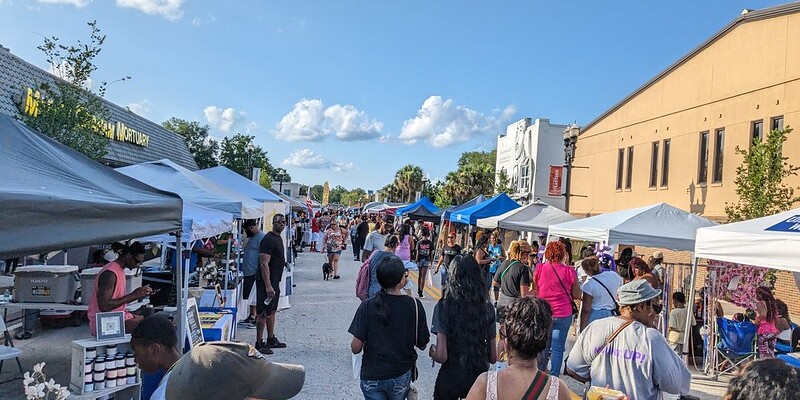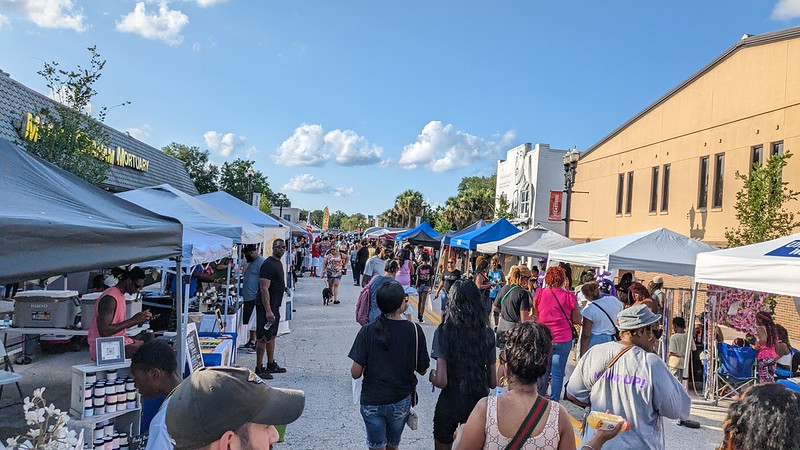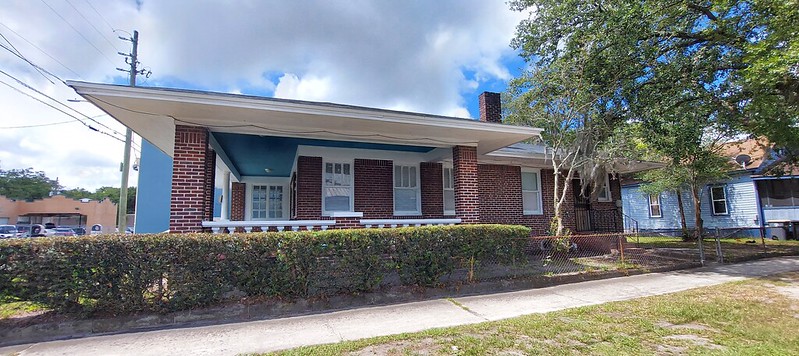
A. Philip Randolph Boulevard was once the center of commerce for residents living east of Downtown Jacksonville until a series of public policy decisions resulted in the economic decline of the Eastside. But now, talk of a new stadium and mixed-use district surrounding the venue presents Jacksonville with the ability to right many longtime economic wrongs. Here’s a look into the history of this important urban corridor and how, with a little intention and focus, Jacksonville’s Eastside could be reborn.

During the first half of the 20th century, A. Philip Randolph Boulevard was the center of commerce for African Americans living in Jacksonville’s Eastside community.
Stretching several blocks from the St. Johns River up to East 8th Street and known as “The Avenue,” the corridor was the place to see and be seen and also connected to Downtown with a streetcar line that ran down its center.
A dense, pedestrian-friendly strip, its continuous line of mixed-use buildings were occupied with mom-and-pop shops, restaurants and clubs, including the Blue Ridge Inn, Charlie Joseph’s grocery store, Johns Furniture and Bill’s Clothing.
Famed residents who frequented the strip include internationally known individuals like Asa Philip Randolph, Zora Neale Hurston, James Weldon Johnson, Billy Daniels and A.L. Lewis.

Like many historic Black commercial districts across the country and in preconsolidated Jacksonville, the Avenue’s fortunes forever changed during the 1950s and 1960s as a result of redlining, racial riots, expressway construction and ultimately what is now known as the Sports & Entertainment District.
In recent years, a coalition of neighborhood residents, business owners and nonprofits have been working to restore and revitalize the Avenue back into its rightful place as one of urban Jacksonville’s most vibrant commercial districts.

Recently, the Jacksonville Jaguars publicly released plans for the Stadium of the Future and the development of a mixed-use sports district on land in the Eastside community and the southern segment of A. Philip Randolph Boulevard that was erased decades ago for the creation of the Sports & Entertainment District. The project, which could cost as much as $2.068 billion, with the city paying 50% of the cost, has led many residents across town to be concerned with further gentrification and displacement of the Eastside community.
As a result, team President Mark Lamping told Jacksonville Today that the team is looking to develop property surrounding the stadium, but not gentrify the neighborhood to the point where current Eastside residents can no longer afford to live there.
“What that is designed to do is bring about needed change in the neighborhood in the way that residents want, so they don’t get displaced; but, there are services — so they are not a food desert any longer, it’s a safer neighborhood — all of those things,” Lamping said.

While most of the Stadium of the Future conversation has focused around the stadium itself, it is time to turn our attention to the needs of the surrounding community, its ongoing “withintrification” efforts and a big economic opportunity that the city of Jacksonville, Jacksonville Jaguars and others can play a significant role in. That is the redevelopment of the neighborhood’s historic commercial district, A. Philip Randolph Boulevard, as a true gateway to the Eastside to the Sports and Entertainment District. Much more important than an improved stadium, this is an unique opportunity to revitalize a significant part of the city that has long been ignored and disenfranchised since consolidation.

If Jacksonville needs inspiration, here a few sports-related mixed-use projects with an extra emphasis in their plans around the revitalization of adjacent historic neighborhoods and their commercial districts:
Greenwood District
Tulsa, Oklahoma

Known as the Black Wall Street due to the large number of successful businesses and wealthy African American inhabitants, Tulsa’s historic Greenwood neighborhood was destroyed in a race riot on June 1st, 1921. As late as the early 2000s, the neighborhood and its central commercial district, Greenwood Avenue, were dominated with vacant lots and underutilized buildings.
In April 2010, Oneok Field, a $40 million minor league baseball stadium, opened in the Greenwood neighborhood. The project included complementary mixed-use development in the surrounding area. Intended to be more directly connected to its urban surroundings than the facility it replaced, the project has led Greenwood Avenue to become a destination that has attracted more people to the neighborhood, creating new economic opportunities for businesses along Greenwood Avenue.



District Detroit
Detroit, Michigan

Woodward Avenue is one of the five principal avenues of Detroit. Platted in 1805 by Judge Augustus B. Woodward, it’s nicknamed “Detroit’s Main Street” because throughout the city’s history, Woodward has served as Detroit’s central commercial spine. Devastated by economic decline following World War II, Woodward just north of Downtown had become a place for Detroit Tiger MLB and Detroit Lions NFL fans to park on game day by the 21st century.
With the 2017 opening of the $862.9 million Little Caesars Arena, this is not the case anymore. The new home of the Detroit Red Wings also serves as the flagship of a new $2.1 billion, 650,000-square-foot sports and entertainment district known as District Detroit. Anchoring District Detroit, along with existing MLB and NFL stadiums, the arena development is designed to be surrounded by offices, retail shops, restaurants and educational facilities, bringing life back to Woodward and the existing shops and businesses in the surrounding Midtown neighborhood.




18th & Vine District
Kansas City, Missouri

18th & Vine was a major Chitlin Circuit destination during segregation and a hub for Kansas City’s African American community. Like the Avenue, 18th & Vine was ravaged by urban renewal during the second half of the 20th century. In 1991, 35 buildings that remained were added to the National Register of Historic Places.
During the late 1990s, the district became the home of the Negro Leagues Baseball Museum. This has led to a series of rehabilitation starts and stops over the past 20 years to bring East 18th Street back its former grandeur. Nevertheless, the use of a baseball museum and the Kansas City MLB Urban Youth Academy to anchor the historic strip and a focus on preserving what remains and complementing it with appropriate infill mixed-use development has resulted in a district where sports, art, music, history and cuisine collide.


Historic Gas Plant District
St. Petersburg, Florida

Just west of Downtown St. Petersburg, the Gas Plant neighborhood was one of the city’s oldest and tightly knit African American communities. Nearly in existence for a century, much of the Gas Plant neighborhood was displaced as the city moved forward with building a stadium to lure a Major League Baseball team to Tampa Bay. That stadium, which uprooted Black residents from their neighborhood, became today’s Tropicana Field and home of the Tampa Bay Rays.
In recent years, the city has decided to attempt to fulfill promises to residents who were forced to relocate by bringing the area back to life with new attainable housing, business opportunities, and overall equitable and impactful economic development that benefits all.
These plans involve working with Hines and the Tampa Bay Rays to serve as the master developers for an 86-acre, $4.6 billion mixed-use district. This includes the redevelopment of the neighborhood’s 16 Street South corridor into a district that serves the surrounding community and an extension of a historic commercial strip that survives today just south of the project. Additional community benefits include $500 million to assist small, local and minority business enterprises, 859 units of affordable/workforce housing and a $50 million Community Benefit Program to intentional equity initiatives in partnership with the South St. Petersburg community.

Contact Ennis at edavis@moderncities.com.







